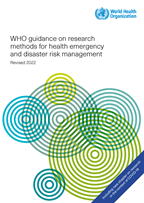- Home/
- Our Work/
- Health Emergencies/
- Research Methods/
- Sections and chapters/
- Section 4: Study design/
- Chapter 4.10 Using logic models in research and evaluation of Health EDRM interventions
Section 4: Study design
Chapter 4.10 Using logic models in research and evaluation of Health EDRM interventions

Research Methods for Health EDRM
Section navigation
- Section 4: Study design
- Chapter 4.10 Using logic models in research and evaluation of Health EDRM interventions
- Chapter 4.1 Basic principles in designing studies to assess the effects of interventions
- Chapter 4.2 Measuring the problem: Basic statistics
- Chapter 4.3 Cluster randomized trials
- Chapter 4.4 Collection and management of good quality data
- Chapter 4.5 Advanced statistical techniques
- Chapter 4.6 Health-related risk modelling
- Chapter 4.7 Evaluating economic impacts in health emergency and disaster risk management
- Chapter 4.8 Geographic information systems
- Chapter 4.9 Real-time syndromic surveillance
- Chapter 4.11 Researching communication and communicating research in Health EDRM
- Chapter 4.12 Qualitative research
- Chapter 4.13 Addressing complexity through mixed methods
- Chapter 4.14 Natural experiments in a hazard context
- Chapter 4.15 Monitoring and evaluation
Authors: Kneale D, Bangpan M, Thomas J, Waddington HS.
Chapter 4.10 explains the importance of logic models and how and when they can be used in the context of Health EDRM:
- The importance of logic models for research and evaluation in Health EDRM.
- Methods for constructing and using a logic model to guide research and evaluation projects.
What is this chapter about?
The mechanisms by which interventions, actions and strategies work is sometimes unclear in Health EDRM. Logic models can be used to help investigate this and to communicate findings from Health EDRM research to decision-makers in order to help them with planning the implementation of an intervention. This includes the identification of relevant outcomes and monitoring intervention delivery.
This chapter outlines the importance of logic models, how and when they can be used to conceptualize how interventions are intended to work, and their relationship with the broader context in which they take place. It focuses on Health EDRM settings and provides a framework of 13 steps for creating and maintaining a logic model. The chapter also explains many of the terms associated with logic models and how these models can be used in a variety of research and evaluation studies.
What are the key messages of this chapter?
- Logic models provide a useful basis for thinking conceptually about how an intervention should ‘work’ to change outcomes. They are a graphical representation of the stages linking intervention inputs and outputs, outcomes and impacts.
- Logic models can be used to reflect assumptions about contexts and to illustrate more complex relationships.
- There are a number of steps to follow when developing a logic model, but perhaps one of the most important elements of good practice is that logic models should be developed with the input of stakeholders to challenge some of the (potentially erroneous) assumptions made by the research team.
